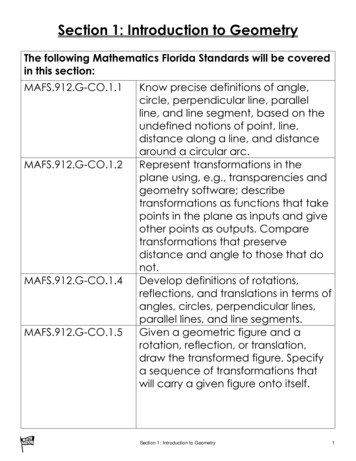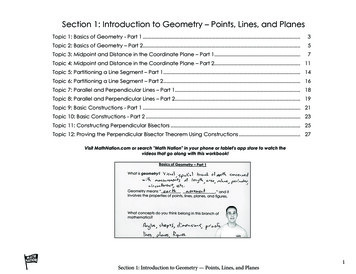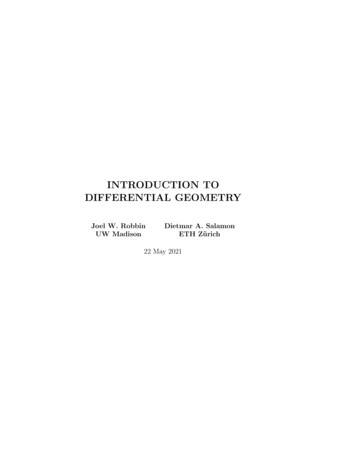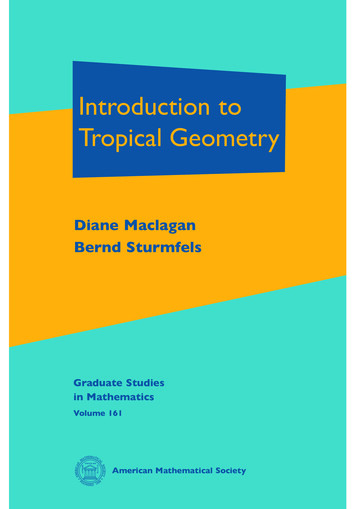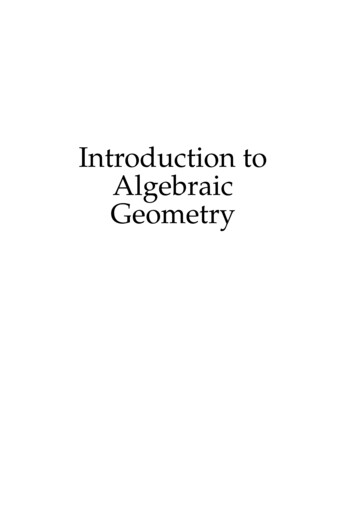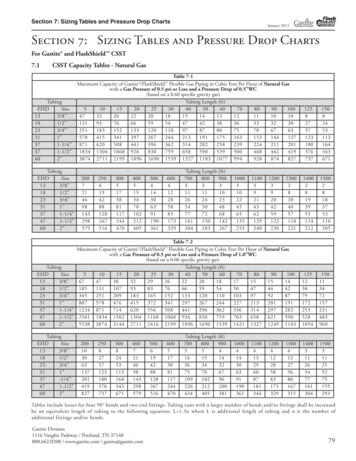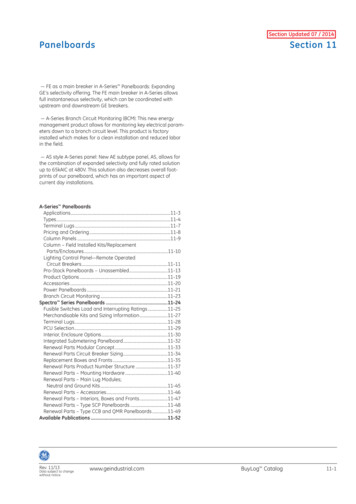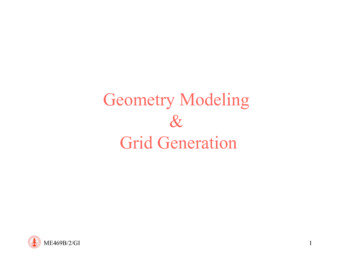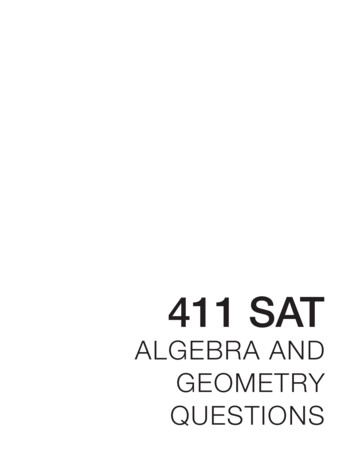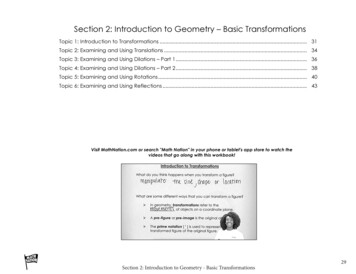
Transcription
Section 2: Introduction to Geometry – Basic TransformationsTopic 1: Introduction to Transformations . 31Topic 2: Examining and Using Translations . 34Topic 3: Examining and Using Dilations – Part 1 . 36Topic 4: Examining and Using Dilations – Part 2 . 38Topic 5: Examining and Using Rotations . 40Topic 6: Examining and Using Reflections . 43Visit MathNation.com or search "Math Nation" in your phone or tablet's app store to watch thevideos that go along with this workbook!Section 2: Introduction to Geometry - Basic Transformations29
The following Mathematics Florida Standards will be covered in this section:G-CO.1.2 - Represent transformations in the plane using, e.g., transparencies and geometry software; describetransformations as functions that take points in the plane as inputs and give other points as outputs. Comparetransformations that preserve distance and angle to those that do not.G-CO.1.4 - Develop definitions of rotations, reflections, and translations in terms of angles, circles, perpendicular lines,parallel lines, and line segments.G-CO.1.5 - Given a geometric figure and a rotation, reflection, or translation, draw the transformed figure. Specify asequence of transformations that will carry a given figure onto itself.30Section 2: Introduction to Geometry - Basic Transformations
Section 2: Introduction to Geometry – BasicTransformationsSection 2 – Topic 1Introduction to TransformationsWhat do you think happens when you transform a figure?What are some different ways that you can transform a figure?ØIn geometry, transformations refer to theof objects on a coordinate plane.ØA pre-figure or pre-image is the original object.ØThe prime notation (" ) is used to represent atransformed figure of the original figure.Consider the graph below, circle the pre-image and box thetransformed image. Describe the transformation.𝑦𝑦𝐴𝐴𝑥𝑥There are two main categories of transformations: rigid andnon-rigid.ØA transformation changes the sizeof the pre-image.ØA transformation does not changethe size of the pre-image.Write a real-world example of a rigid transformation.Write a real-world example of a non-rigid transformation.There are four common types of transformations:ØA rotation turns the shape around a center point.ØA translation slides the shape in any direction.ØA dilation changes the size of an object through anenlargement or a reduction.ØA reflection flips the object over a line (as in a mirrorimage).𝐴𝐴′’Section 2: Introduction to Geometry - Basic Transformations31
In the table below, indicate whether the transformation is rigidor non-rigid and justify your , identify the transformations shown in the followinggraphs and write the names of the transformations in thecorresponding boxes under each graph.𝑦𝑦𝑦𝑦Justificationo Rigido 𝐴𝐴’𝐶𝐶Dilation32𝐶𝐶′𝑥𝑥o Rigido Non-Rigid𝑦𝑦Rotation𝐶𝐶𝐵𝐵’o Rigido Non-Rigid𝐴𝐴’𝐵𝐵’𝐵𝐵𝐴𝐴 𝐶𝐶′ 𝐶𝐶o Rigido Non-RigidSection 2: Introduction to Geometry - Basic �𝐶𝐶𝐶′𝐵𝐵’𝐴𝐴’𝑥𝑥
Let’s Practice!Try It!1.2.Consider 𝐴𝐴𝐴𝐴 in the coordinate plane below.a.Write the coordinates of each endpoint, the length ofthe segment, and the midpoint of the segment.Consider the transformations of 𝐴𝐴𝐴𝐴 in the previousproblem.a.𝑦𝑦𝐴𝐴𝐵𝐵𝐴𝐴 ,𝑥𝑥𝐴𝐴′𝐵𝐵 ,𝐵𝐵′Length: units𝐵𝐵′Midpoint: ,b.Trace the lines and identify the transformations on 𝐵𝐵′𝐴𝐴′𝑥𝑥Write the coordinates of A′ and B′ after the ��𝐴 is translated 5 units up and 3 units tothe left.𝐴𝐴𝐴𝐴 is rotated 180 clockwise about theorigin.𝑨𝑨′𝑩𝑩′b.What are the 𝐴𝐴′ and 𝐵𝐵′ coordinates for eachtransformation below? Fill in the length and midpointof each segment indicated in the ′ , ; 𝐵𝐵′ �� , ; 𝐵𝐵′ ,𝐴𝐴′ , ; 𝐵𝐵′ ,𝐴𝐴′ , ; 𝐵𝐵′ ,Section 2: Introduction to Geometry - Basic Transformations33
BEAT THE TEST!1.Three rays share the same vertex (5, 4) as shown in thecoordinate plane below.𝑦𝑦Figure AFigure B𝑥𝑥Figure CSection 2 – Topic 2Examining and Using TranslationsA translation "slides" an object a fixed distance in a givendirection, preserving the same and .Suppose a geometric figure is translated ℎ units along the𝑥𝑥-axis and 𝑘𝑘 units along the 𝑦𝑦-axis. We use the followingnotation to represent the transformation:𝑇𝑇B,C 𝑥𝑥, 𝑦𝑦 (𝑥𝑥 ℎ, 𝑦𝑦 𝑘𝑘) or 𝑥𝑥, 𝑦𝑦 (𝑥𝑥 ℎ, 𝑦𝑦 𝑘𝑘)Ø𝑥𝑥, 𝑦𝑦 𝑥𝑥 2, 𝑦𝑦 5 translates the point (𝑥𝑥, 𝑦𝑦) 2 unitsand 5 units .ØWhat is the algebraic description for a transformationthat translates the point 𝑥𝑥, 𝑦𝑦 2 units to the left and 3units upward?ØWhat is the algebraic description for a transformationthat translates the point 𝑥𝑥, 𝑦𝑦 3 units to the right and 2units downward?CPart A: Which figure represents a reflection across the𝑦𝑦-axis?Part B: Which of the following statements are true aboutthe figure? Select all that apply.o A rotation of 360 will carry the object ontoitself.o A reflection of the figure along the 𝑥𝑥-axiscarries the figure to Quadrant II.o In Figure A, 𝑥𝑥 " , 𝑦𝑦 " 𝑥𝑥 10, 𝑦𝑦 .o If the vertex of Figure A is translated(𝑥𝑥 1, 𝑦𝑦 9), it will carry onto the vertex ofFigure B.o Figure C is a reflection on the 𝑥𝑥-axis of Figure A.34Section 2: Introduction to Geometry - Basic Transformations
Let’s Practice!Try It!1.3.Transform triangle 𝐴𝐴𝐴𝐴𝐴𝐴 according to 𝑥𝑥, 𝑦𝑦 (𝑥𝑥 3, 𝑦𝑦 2).Write the coordinates for triangle 𝐵𝐵𝑦𝑦𝑦𝑦𝐴𝐴′ ,𝑥𝑥𝐴𝐴𝐵𝐵′ ,𝐶𝐶′ ,2.𝐴𝐴𝐴𝐴 undergoes the translation 𝑇𝑇B,C 𝑥𝑥, 𝑦𝑦 , such that 𝐴𝐴′ 1, 1and 𝑃𝑃" (4, 3).a.When the transformation 𝑥𝑥, 𝑦𝑦 (𝑥𝑥 10, 𝑦𝑦 5) isperformed on point 𝐴𝐴, its image, point 𝐴𝐴′, is on the origin.What are the coordinates of 𝐴𝐴? Justify your answer.𝑃𝑃𝑥𝑥What are the values of ℎ and 𝑘𝑘?ℎ units𝑘𝑘 unitsb.Which of the following statements is ���𝐴𝐴𝐴𝐴𝐴and 𝐴𝐴′𝑃𝑃′ have different locations.and 𝐴𝐴′𝑃𝑃′ have different shapes.and 𝐴𝐴′𝑃𝑃′ have different sizes.and 𝐴𝐴′𝑃𝑃′ have different directions.Section 2: Introduction to Geometry - Basic Transformations35
BEAT THE TEST!1.When the transformation 𝑥𝑥, 𝑦𝑦 (𝑥𝑥 4, 𝑦𝑦 7) is performedon point 𝑃𝑃, its image is point 𝑃𝑃′( 3, 4). What are thecoordinates of 𝑃𝑃?ABCD2.( 7, 11)( 1, 3)(1, 3)(7, 11)Section 2 – Topic 3Examining and Using Dilations – Part 1Dilation stretches or shrinks the original figure.Consider the following figure.Consider the following points.𝑅𝑅( 6, 5) and 𝑈𝑈(5, 6)𝑅𝑅𝑅𝑅 undergoes the translation 𝑥𝑥, 𝑦𝑦 (𝑥𝑥 ℎ, 𝑦𝑦 𝑘𝑘), suchthat 𝑅𝑅′ 5, 1 and 𝑈𝑈 " (16, 10).Part A: Complete the following algebraic description.What is making the projected image shrink or grow?The center of dilation is a fixed point in the plane about whichall points are expanded or contracted.How different is one line from the other in the above figure?𝑥𝑥, 𝑦𝑦 (𝑥𝑥 , 𝑦𝑦 )Part B: What is the difference between 𝑅𝑅𝑅𝑅 and 𝑅𝑅′𝑈𝑈′?36The scale factor refers to how much the figure grows or shrinks,and it is denoted by 𝑘𝑘.ØIf 0 𝑘𝑘 1, the image gets smaller and closer to thecenter of dilation.ØIf 𝑘𝑘 1, the image gets larger and farther from thecenter of dilation.Section 2: Introduction to Geometry - Basic Transformations
Consider the following graph.Consider the following graph.𝑦𝑦𝑦𝑦𝑥𝑥How do you dilate the line segment on the above graphcentered at a point on the same line?Use (2, 4) as the center of dilation and complete the following:ØIf 𝑘𝑘 2, then the dilated line segment will havecoordinates: and .Ø𝑥𝑥How do you dilate the line segment on the above graphcentered at the origin?ØIf 𝑘𝑘 2, then the dilated line segment will havecoordinates: and .If 𝑘𝑘 , then the dilated line segment will haveØIf 𝑘𝑘 , then the dilated line segment will haveWhen dilating a line that passes through the center ofdilation, the line is .ØWhen dilating a line that does not pass through thecenter of dilation, the dilated line is tothe original.Ø(𝑥𝑥, 𝑦𝑦) (𝑘𝑘𝑘𝑘, 𝑘𝑘𝑘𝑘) changes the size of the figure by afactor of k when the center of dilation is the origin.LMcoordinates: and .ØLMcoordinates: and .Section 2: Introduction to Geometry - Basic Transformations37
Section 2 – Topic 4Examining and Using Dilations – Part 2Consider the following graph.𝑦𝑦Let’s Practice!1.𝑥𝑥𝐴𝐴𝐴𝐴 has coordinates 𝐴𝐴 3, 9 and 𝐵𝐵 6, 12 . 𝑃𝑃𝑃𝑃 hascoordinates 𝑃𝑃 3, 6 and 𝑄𝑄 3, 9 .a.Find the coordinates of 𝐴𝐴′𝐵𝐵′ after a dilation with aMscale factor of centered at the origin.Qb.Use (9, 6) as the center of dilation and complete the followingstatements:ØØIf 𝑘𝑘 4, then the dilated line segment will have thecoordinates and .R2.LIf 𝑘𝑘 , then the dilated line segment will have theOcoordinates and .38A dilation produces an image that is the sameas the original, but is a different .ØWhen dilating a line segment, the dilated linesegment is longer or shorter with respect to the.Line 𝑙𝑙 is mapped onto the line 𝑡𝑡 by a dilation centered atthe origin with a scale factor of 3. The equation of line 𝑙𝑙 is2𝑥𝑥 𝑦𝑦 7. What is the equation for line 𝑡𝑡?A 6𝑥𝑥 3𝑦𝑦 21LB LU 𝑥𝑥 𝑦𝑦 MLC 𝑦𝑦 2𝑥𝑥 21D 𝑦𝑦 6𝑥𝑥 21In conclusion,ØFind the coordinates of 𝑃𝑃′𝑄𝑄′ after a dilation with aLscale factor of centered at (3, 1).3.Suppose the line 𝑙𝑙 represented by 𝑓𝑓 𝑥𝑥 2𝑥𝑥 1 istransformed into 𝑔𝑔 𝑥𝑥 2 𝑓𝑓 𝑥𝑥 1 7.a.Describe the transformation from 𝑓𝑓(𝑥𝑥) to 𝑔𝑔(𝑥𝑥).b.What is the 𝑦𝑦-coordinate of 𝑔𝑔(0)?Section 2: Introduction to Geometry - Basic Transformations
Try It!4.BEAT THE TEST!What is the scale factor for the dilation of 𝐴𝐴𝐴𝐴𝐴𝐴 into ��’𝐴𝐴’ 𝐵𝐵’𝐴𝐴5.𝐶𝐶𝑥𝑥𝑘𝑘 𝐵𝐵a.b.𝑥𝑥, 𝑦𝑦 (2.𝐶𝐶𝐶𝐶 has coordinates 𝐶𝐶 8, 2 and 𝐷𝐷 4, 12 .Determine the coordinates of 𝐶𝐶′𝐷𝐷′ if (𝑥𝑥, 𝑦𝑦) (3𝑥𝑥, 3𝑦𝑦).Find the coordinates of 𝐶𝐶′𝐷𝐷′ after a dilation with ascale factor of 2 centered at (2, 2).𝑀𝑀′𝑇𝑇′ has coordinates 𝑀𝑀′ 8, 10 and 𝑇𝑇′ 2, 4 , and it is theresult of the dilation of 𝑀𝑀𝑀𝑀 centered at the origin. Thecoordinates of 𝑀𝑀𝑀𝑀 are 𝑀𝑀 4, 5 and 𝑇𝑇 1, 2 . Completethe following algebraic description so that it represents thetransformation of 𝑀𝑀𝑀𝑀.𝑥𝑥,𝑦𝑦)Line 𝑙𝑙 is mapped onto line 𝑚𝑚 by a dilation centered at theOorigin with a scale factor of . Line 𝑚𝑚 is represented byR𝑦𝑦 3𝑥𝑥 8 and it passes through the point whichcoordinates are ( 4, 4). Which of the following is trueabout line 𝑙𝑙?ABCDLine 𝑙𝑙Line 𝑙𝑙Line 𝑙𝑙Line 𝑙𝑙is parallel to line 𝑚𝑚.is perpendicular to line 𝑚𝑚.passes through the origin.is the same as line 𝑚𝑚.Section 2: Introduction to Geometry - Basic Transformations39
3.Section 2 – Topic 5Examining and Using Rotations𝑃𝑃( 6, 10), 𝑄𝑄( 10, 4) and 𝑅𝑅( 4, 2) form figure 𝑃𝑃𝑃𝑃𝑃𝑃.𝑦𝑦A rotation changes the of a figure by moving itaround a fixed point to the right (clockwise) or to the ’Let’s consider the following art A: Gladys transformed figure 𝑃𝑃𝑃𝑃𝑃𝑃 into 𝑃𝑃′𝑄𝑄′𝑅𝑅′. Whichof the following represents her transformation?ABCD𝑥𝑥, 𝑦𝑦𝑥𝑥, 𝑦𝑦𝑥𝑥, 𝑦𝑦𝑥𝑥, 𝑦𝑦LL ( 𝑥𝑥, 𝑦𝑦)MM (2𝑥𝑥, 2𝑦𝑦) (𝑥𝑥 3, 𝑦𝑦 5) (𝑥𝑥 3, 𝑦𝑦 5)Part B: She then transformed 𝑃𝑃′𝑄𝑄′𝑅𝑅′ into 𝑃𝑃′′𝑄𝑄′′𝑅𝑅′′. What isthe transformation?(𝑥𝑥, 𝑦𝑦) ,Use the graph to help you determine the coordinates for (𝑥𝑥’, 𝑦𝑦’)after the following rotations about the origin.DegreeCounterclockwiseClockwise90 Rotation:𝑅𝑅\] 3, 4 𝑅𝑅 \] 3, 4 180 Rotation:270 Rotation:𝑅𝑅L ] 3, 4 𝑅𝑅M ] 3, 4 𝑅𝑅 L ] 3, 4 𝑅𝑅 M ] 3, 4 The function 𝑅𝑅a 𝑥𝑥, 𝑦𝑦 rotates the point (𝑥𝑥, 𝑦𝑦) 𝑡𝑡 around the origin.The function 𝑅𝑅 a 𝑥𝑥, 𝑦𝑦 rotates the point (𝑥𝑥, 𝑦𝑦) 𝑡𝑡 around the origin.40Section 2: Introduction to Geometry - Basic Transformations
Make generalizations about rotations around the origin tocomplete the following table.DegreeCounterclockwiseClockwise90 Rotation:𝑥𝑥, 𝑦𝑦 𝑥𝑥, 𝑦𝑦 270 Rotation:𝑥𝑥, 𝑦𝑦 𝑥𝑥, 𝑦𝑦 180 Rotation:𝑥𝑥, 𝑦𝑦 Let’s Practice!1.𝑥𝑥, 𝑦𝑦 What happens if the rotation is 360 clockwise orcounterclockwise?What happens if the center of rotation is not the origin?2.𝑅𝑅𝑅𝑅 has endpoints 𝑅𝑅(0, 3) and 𝑇𝑇(4, 1). Rotate 𝑅𝑅𝑅𝑅 clockwise90 about the origin.a.Write an algebraic description of the transformation of𝑅𝑅𝑅𝑅.b.What are the endpoints of the new line segment?Let’s consider the following graph.𝑦𝑦What happens if the degree of rotation is a degree other than90 , 180 , 270 , and 360 ?𝑥𝑥Rotate (3, 4) counterclockwise 90 about (5, 7).Section 2: Introduction to Geometry - Basic Transformations41
Try It!3.BEAT THE TEST!Consider the following graph.1.𝑃𝑃𝑃𝑃 has endpoints 𝑃𝑃( 2, 1) and 𝑄𝑄(6, 5). Consider thetransformation (𝑥𝑥, 𝑦𝑦) (𝑦𝑦, 𝑥𝑥) for 𝑃𝑃𝑃𝑃. What kind oftransformation is this? What are the coordinates of 𝑃𝑃′𝑄𝑄′?2.Point 𝐾𝐾(10, 3) is rotated 90 clockwise. Which of thefollowing is the 𝑦𝑦 coordinate of ��𝐵Rotate figure 𝐴𝐴𝐴𝐴𝐴𝐴 270 counterclockwise about theorigin. Graph the new figure on the coordinate plane,and complete each blank below with theappropriate coordinates.ABCD 10 3310𝐴𝐴 , 𝐴𝐴′( , )𝐵𝐵 , 𝐵𝐵′( , )𝐶𝐶 , 𝐶𝐶′( , )Rotate figure 𝐴𝐴𝐴𝐴𝐴𝐴 90 clockwise about the origin.Graph the new figure on the coordina
Section 2: Introduction to Geometry – Basic Transformations Section 2 – Topic 1 Introduction to Transformations What do you think happens when you transform a figure? What are some different ways that you can transform a figure? Ø In geometry, transformations refer to the _ of objects on a coordinate plane. Ø A pre-figure or pre-image is the original object. Ø The "prime notation is .
